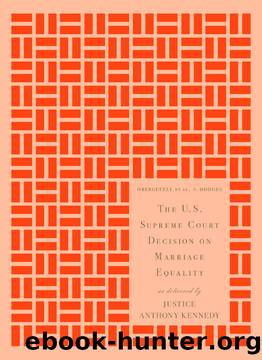The U.S. Supreme Court Decision on Marriage Equality by Anthony M. Kennedy

Author:Anthony M. Kennedy [Kennedy, Anthony M.]
Language: eng
Format: epub
ISBN: 978-1-61219-533-9
Publisher: Melville House
Published: 2015-11-03T00:00:00+00:00
And in Turner, the Court again acknowledged the intimate association protected by this right, holding prisoners could not be denied the right to marry because their committed relationships satisfied the basic reasons why marriage is a fundamental right. See 482 U. S., at 95â96. The right to marry thus dignifies couples who âwish to define themselves by their commitment to each other.â Windsor, supra, at ___ (slip op., at 14). Marriage responds to the universal fear that a lonely person might call out only to find no one there. It offers the hope of companionship and understanding and assurance that while both still live there will be someone to care for the other.
As this Court held in Lawrence, same-sex couples have the same right as opposite-sex couples to enjoy intimate association. Lawrence invalidated laws that made same-sex intimacy a criminal act. And it acknowledged that â[w]hen sexuality finds overt expression in intimate conduct with another person, the conduct can be but one element in a personal bond that is more enduring.â 539 U. S., at 567. But while Lawrence confirmed a dimension of freedom that allows individuals to engage in intimate association without criminal liability, it does not follow that freedom stops there. Outlaw to outcast may be a step forward, but it does not achieve the full promise of liberty.
A third basis for protecting the right to marry is that it safeguards children and families and thus draws meaning from related rights of childrearing, procreation, and education. See Pierce v. Society of Sisters, 268 U. S. 510 (1925); Meyer, 262 U. S., at 399. The Court has recognized these connections by describing the varied rights as a unified whole: â[T]he right to âmarry, establish a home and bring up childrenâ is a central part of the liberty protected by the Due Process Clause.â Zablocki, 434 U. S., at 384 (quoting Meyer, supra, at 399). Under the laws of the several States, some of marriageâs protections for children and families are material. But marriage also confers more profound benefits. By giving recognition and legal structure to their parentsâ relationship, marriage allows children âto understand the integrity and closeness of their own family and its concord with other families in their community and in their daily lives.â Windsor, supra, at ___ (slip op., at 23). Marriage also affords the permanency and stability important to childrenâs best interests. See Brief for Scholars of the Constitutional Rights of Children as Amici Curiae 22â27.
As all parties agree, many same-sex couples provide loving and nurturing homes to their children, whether biological or adopted. And hundreds of thousands of children are presently being raised by such couples. See Brief for Gary J. Gates as Amicus Curiae 4. Most States have allowed gays and lesbians to adopt, either as individuals or as couples, and many adopted and foster children have same-sex parents, see id., at 5. This provides powerful confirmation from the law itself that gays and lesbians can create loving, supportive families.
Excluding same-sex couples from marriage thus conflicts with a central premise of the right to marry.
Download
This site does not store any files on its server. We only index and link to content provided by other sites. Please contact the content providers to delete copyright contents if any and email us, we'll remove relevant links or contents immediately.
Objection! by Nancy Grace(1335)
Anatomy of Injustice by Raymond Bonner(1273)
Apeirogon by Colum McCann(1252)
That Every Man Be Armed by Stephen P. Halbrook(1242)
Injustices by Ian Millhiser(1203)
The Vaccine Court by Rohde Wayne(1194)
Civil Procedure (Aspen Casebooks) by Stephen C. Yeazell(1182)
Storytelling for Lawyers by Meyer Philip(1141)
Restitution by Restitution(1118)
A Practical Guide to International Arbitration in London by Hilary Heilbron(1087)
Coercing Virtue by Robert H. Bork(1030)
Tangled Webs: How False Statements Are Undermining America: From Martha Stewart to Bernie Madoff by James B. Stewart(1028)
The Tools of Argument: How the Best Lawyers Think, Argue, and Win by Joel Trachtman(1028)
Broken Scales by Joel Cohen(1022)
INDEFENSIBLE: One Lawyer's Journey Into the Inferno of American Justice by Feige David(1013)
American Tragedy by Lawrence Schiller & James Willwerth(962)
A Religious Orgy in Tennessee by H.L. Mencken(954)
A Matter of Interpretation by Antonin Scalia(944)
Tangled Webs by James B. Stewart(927)
